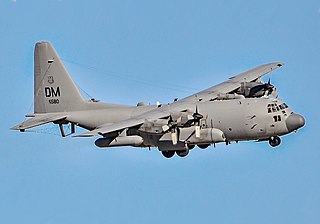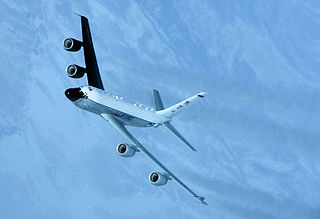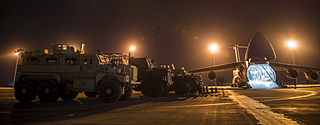Related Research Articles

Strategic Air Command (SAC) was a United States Department of Defense Specified Command and a United States Air Force (USAF) Major Command responsible for command and control of the strategic bomber and intercontinental ballistic missile components of the United States military's strategic nuclear forces from 1946 to 1992. SAC was also responsible for strategic reconnaissance aircraft; airborne command posts; and most of the USAF's aerial refueling aircraft.

Davis–Monthan Air Force Base is a United States Air Force base 5 miles southeast of downtown Tucson, Arizona. It was established in 1925 as Davis–Monthan Landing Field. The host unit for Davis–Monthan AFB is the 355th Wing assigned to Twelfth Air Force (12AF), part of Air Combat Command (ACC). The base is best known as the location of the Air Force Materiel Command's 309th Aerospace Maintenance and Regeneration Group, the aircraft boneyard for all excess military and U.S. government aircraft and aerospace vehicles.

Offutt Air Force Base is a U.S. Air Force base south of Omaha, adjacent to Bellevue in Sarpy County, Nebraska. It is the headquarters of the U.S. Strategic Command (USSTRATCOM), the 557th Weather Wing, and the 55th Wing of the Air Combat Command (ACC), the latter serving as the host unit.

The Sixteenth Air Force (Air Forces Cyber) (16 AF) is a United States Air Force (USAF) organization responsible for information warfare, which encompasses intelligence gathering and analysis, surveillance, reconnaissance, cyber warfare and electronic warfare operations. Its headquarters is at Joint Base San Antonio-Lackland in Texas.

The EC-130H Compass Call is an electronic attack aircraft flown by the United States Air Force. Based on the Lockheed C-130 Hercules, the aircraft is heavily modified to disrupt enemy command and control communications, perform offensive counterinformation operations, and carry out other kinds of electronic attacks. Planned upgrades will add the ability to attack early warning and acquisition radars. Based at Davis-Monthan AFB in Arizona, EC-130Hs can be deployed worldwide at short notice to support U.S. and allied strategic and tactical air, surface, and special operations forces.

The 557th Weather Wing is a United States Air Force formation and its lead military meteorology center. It reports environmental situational awareness worldwide to the Air Force, the United States Army, joint warfighters, Unified Combatant Commands, the national intelligence community, and the Secretary of Defense. It is headquartered at Offutt Air Force Base, in Bellevue, Nebraska.

The 55th Wing is a United States Air Force unit assigned to Air Combat Command. The wing is primarily stationed at Offutt Air Force Base, Nebraska, but maintains one of its groups and associated squadrons at Davis-Monthan Air Force Base, Arizona, as a geographically separated unit.

The Strategic Automated Command and Control System (SACCS) is a United States Strategic Command command and control system for intercontinental ballistic missiles, nuclear-armed long-range bombers, and ballistic missile submarines.

The 6th Space Operations Squadron is an Air Force Reserve satellite command and control squadron located at Schriever Space Force Base, Colorado. The squadron is a backup to NOAA for Defense Meteorological Satellite Program operations.

Looking Glass is the historic code name for an airborne command and control center operated by the United States. In more recent years it has been more officially referred to as the ABNCP. It provides command and control of U.S. nuclear forces in the event that ground-based command centers have been destroyed or otherwise rendered inoperable. In such an event, the general officer aboard the Looking Glass serves as the Airborne Emergency Action Officer (AEAO) and by law assumes the authority of the National Command Authority and could command execution of nuclear attacks. The AEAO is supported by a battle staff of approximately 20 people, with another dozen responsible for the operation of the aircraft systems. The name Looking Glass, which is another name for a mirror, was chosen for the Airborne Command Post because the mission operates in parallel with the underground command post at Offutt Air Force Base.

The 170th Group is a unit of the Nebraska Air National Guard, stationed at Offutt Air Force Base, Nebraska. If activated to federal service, the group would be gained by the United States Air Force Air Combat Command.
The National Program Office (NPO) was an office of the United States Government, established to ensure continuity of government in the event of a national disaster. The NPO was established by a secret executive order signed on 14 September 1982 by President Ronald Reagan during the Cold War in preparation for a nuclear war, presumably with the Soviet Union.

The 38th Reconnaissance Squadron is a United States Air Force unit. It is a part of the 55th Wing at Offutt Air Force Base, Nebraska. It operates the Boeing RC-135 aircraft conducting reconnaissance missions.

The 818th Strategic Aerospace Division is an inactive United States Air Force organization. Its last assignment was with Strategic Air Command at Lincoln Air Force Base, Nebraska, where it was inactivated on 25 March 1965.

The 385th Air Expeditionary Group is a provisional United States Air Force unit assigned to Air Mobility Command to activate or inactivate as needed. It was last known to be stationed at Incirlik AB, Turkey. It is currently a tenant unit of the 379th Air Expeditionary Wing at Al Udeid Air Base, Qatar.

The 2nd Weather Squadron is an active United States Air Force unit assigned to the 2nd Weather Group of the 557th Weather Wing and is headquartered at Offutt Air Force Base, Nebraska. The squadron's mission is broad and includes the preparation of weather analysis for the intelligence community, observation of space weather, monitoring of volcanic ash, cloud analysis, production of weather broadcasts for the American Forces Network, as well as other tasks. The squadron's personnel is located at seven different sites worldwide.

The United States Air Force's 55th Mobile Command and Control Squadron was a mobile command and control unit located at Offutt AFB, Nebraska.
The United States Air Force's 3d Command and Control Squadron was a command and control unit located at Offutt AFB, Nebraska.

The Post Attack Command and Control System (PACCS) was a network of communication sites for use before, during and after a nuclear attack on the United States. PACCS was designed to ensure that National Command Authority would retain exclusive and complete control over US nuclear weapons. Among other components, it included Strategic Air Command assets such as the Looking Glass aircraft and mission, and various hardened command and control facilities.

The ITT 465L Strategic Air Command Control System was a Cold War "Big L" network of computer and communication systems for command and control of Strategic Air Command "combat aircraft, refueling tankers, [and] ballistic missiles". International Telephone and Telegraph was the prime contractor for Project 465, and SACCS had "Cross Tell Links" between command posts at Offutt AFB, March AFB, & Barksdale AFB (SACCS also communicated with the Cheyenne Mountain Complex and Air Force command posts. The 465L System included IBM AN/FSQ-31 SAC Data Processing Systems, Remote and Simplex Remote Communication Systems, SAC Network Control Office, "4-wire, Schedule 4, Type 4B alternate voice-data operation", and one-way communication with "ICBM launch control centers" In addition to IBM for the "Super SAGE type computers", another of the 6 direct subcontractors was AT&T,
References
- ↑ HERT Development of Concept of Operations, History of 3D Weather Wing, Offutt AFB, Nebraska, 1 July 1984 - 31 Dec 1984
